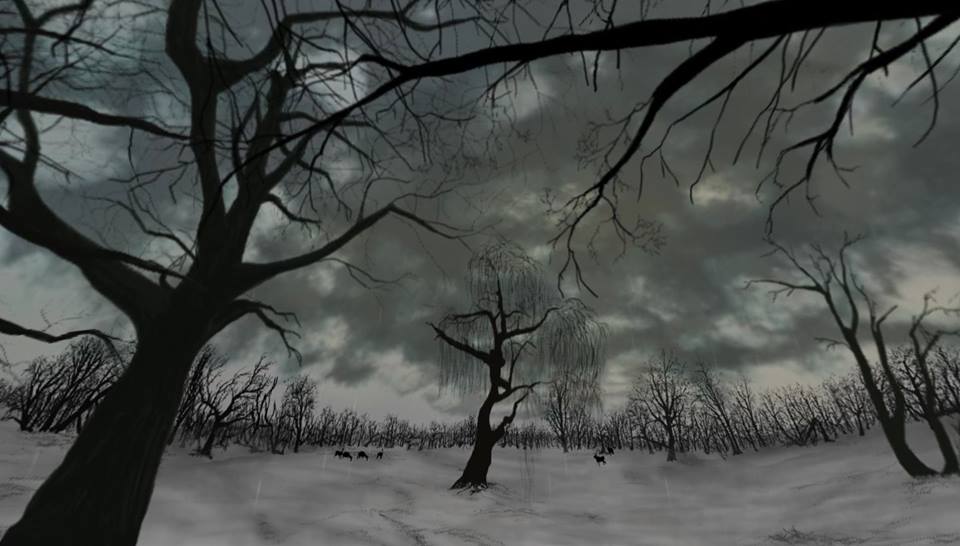Oops, that was what you call a lightning visit. After one night at EYE, it was Kaleidoscope World Tour VR Film Festival already on its way to the next stop on its world tour. A demonstration programme with some 30 examples of what can be enjoyed via virtual reality headsets from Samsung, Oculus Rift and others. On those videos themselves, I don't want to dwell too long now - see other examples in a previous article. Although I noticed again that animation often does best in the 360-degree films intended as reality simulations.
But is it actually film? I enjoyed spending about ten minutes in the winter forest landscape of Februar, overlooking a party in a house further away. Maarten Isaäk de Heer made this animation with support from the Film Fund, which initially saw little in it. After all, it lacked a story.

That's where we hit a sensitive point. VR is being compared to everything from film and games to immersive theatre and performance. Creators trying to tell a story in this new and enthusiastically hyped medium quickly encounter difficulties. Which, according to true VR adepts, is only a sign that we are dealing with an entirely new, unexplored medium.
Kaleidoscope representative Nick even effortlessly mouthed words like 'incredible', 'awesome' and 'amazing', and even suggested a 'new level of consiousness'.
This was to introduce a panel with four VR creators invited to shine their light on some burning VR issues. From this somewhat chaotic Q&A with Arjan van Meerten, Daniël Ernst, Irene Vander Tig and Pierre Friquet, at least the following could be distilled:
The techniques that made classic cinema of the past century such a stunningly effective storytelling machine are often useless in VR.
Montage is just confusing - you shouldn't think of ending up in a new place every few seconds as a viewer. Another example is the close up, which doesn't exist in VR. Yes, you can stand very close to someone in that virtual reality, but that is something completely different and especially confrontational. Like when, after the ferocious psychedelic cosmic trip of Waves is unexpectedly dropped on a beach, right next to a young woman in a swimming costume.
On another occasion, I had also been told that a classic film genre like slapstick does not work in VR because it is too real. Then there is no more to laugh at.
It has, the panel explains, everything to do with the viewer's completely different position. 'What should I do', the latter asks himself here in the first place, instead of simply watching like a film. Film works with codes that we turn into a story with the rational part of our brain. VR works in reverse. With our subconscious we experience it as real, after which the rational tells us it is only VR.
Do I get this? I am trying to compare it to a rollercoaster ride. No one claims that is a story either. Daniel Ernst calls his pieces dioramas.
Towards the end, someone mentions the dream as a metaphor, which seems very appropriate. Very successful for me so far have been VR experiences in which gravity seems to fall away.
Returning to the woman on the beach: she looks at me and asks if I fancy a walk. She slowly walks away along the waterline. I want to follow her, but I fail to move from my seat.
The Kaleidoscope festival is speeding along again. For those who want to dive into the VR world on their own, a selection of VR glasses is now (or soon will be) available. From cheap cardboard viewers (EYE has one for a tenner) into which you slide a modern smartphone, to the more advanced and more expensive models from the likes of Samsung, Sony, Oculus and HTC Vive. The latter also allow you to actually walk around in virtual space and use game-like applications.
To download and experience the content, you usually need to install an app first, such as the one available for free from co-organiser of the festival, for example WeVR. The VR productions themselves have to be paid for. Such a construction is likely to become the main distribution model in the future.
Free VR can already be viewed in this way via, for example, the website of the New York Times.
Kaleidoscope, the festival's main organiser, is a San Francisco-based company that aims to bring independent VR artists together with producers, fincanciers and distributors.
